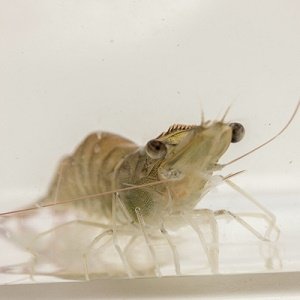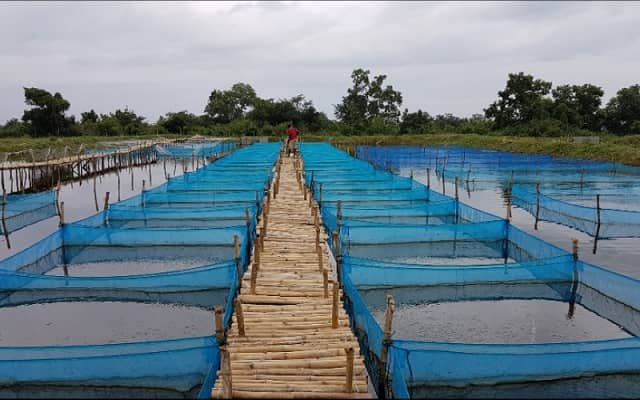
In the current aquaculture industry, there is a trend where every 3 to 5 years, an unknown pathogen emerges, rapidly spreading and causing losses in aquaculture production.
Among infectious agents in aquaculture, bacteria are the most serious ones affecting cultured species.
In this regard, a team of scientists from Wageningen Bioveterinary Research, the Food and Agriculture Organization of the United Nations (FAO), the Asian Institute of Technology, the Vietnam National University of Agriculture, the Institute of Aquaculture at the University of Stirling, among other international scientific organizations, published a scientific review on common and emerging bacterial pathogens affecting tilapia farming, including those with zoonotic potential.
The study includes bacterial diseases such as streptococcosis, Aeromonas septicemia, francisellosis, columnaris disease, and vibriosis. Furthermore, they provide information on emerging bacterial infections of interest for tilapia, such as edwardsiellosis caused by Edwardsiella ictaluri and E. tarda, as well as Aeromonas schubertii.
Here is a brief summary of the study; however, we recommend reviewing the entire document, which you can download at the end of this article.
Bacterial Diseases of Importance
According to the study, tilapia can be infected by various types of bacteria, including species from the genera Vibrio, Aeromonas, Pseudomonas, and Streptococcus.
In general, most fish diseases are induced by stress, such as suboptimal farming conditions, often characterized by poor water quality.
Streptococcosis
Outbreaks of streptococcosis have been reported in tilapia species worldwide, described as a septicemic infection caused by the bacterial species S. iniae or S. agalactiae.
Stay Always Informed
Join our communities to instantly receive the most important news, reports, and analysis from the aquaculture industry.
Streptococcus agalactiae can cause chronic or acute diseases in tilapia. Clinical presentations of the acute form include erratic swimming, unilateral or bilateral exophthalmia, distended abdomen, and hemorrhages.
Several studies have reported meningoencephalitis in infected tilapia, as the bacteria cross the blood-brain barrier, and similar clinical signs of the disease were observed in both naturally and experimentally infected tilapia with S. iniae or S. agalactiae.
In the chronic form, yellow or dark red nodules were observed in the musculature near the spine of Nile tilapia. An outbreak or cumulative mortality during chronic streptococcosis in tilapia can reach 80%, while monthly isolation prevalence varied from 0% to 32% throughout the year.
“Given that S. agalactiae and S. iniae can be zoonotic, in the case of a chronic infection, fish farmers may have prolonged exposure to the bacteria without clear clinical signs. This imposes a risk to fish farmers, fish processors, and consumers,” state the authors of the study.
Aeromoniasis
Aeromonas spp. are found in freshwater environments and are described as infectious and opportunistic organisms that can cause diseases in fish.
Various studies have reported A. hydrophila as one of the main bacterial pathogens in tilapia farming, causing not only high mortality and disease in farmed fish but also in wild fish.
It has been reported that aquatic animals infected with Aeromonas can suffer from acute and chronic diseases, including hemorrhagic septicemia, skin ulcers, and enteritis, with an average mortality rate of 30%.
According to scientists, the most common species associated with natural outbreaks in farmed tilapia include A. hydrophila, A. sobria, A. dhakensis, A. veronii, and A. jandaei.
Tilapia infected with A. hydrophila and A. veronii displayed lethargy and apathy, along with ulcerations, pale spots, and hemorrhages along their bodies.
Francisellosis
Francisella orientalis, formerly known as F. noatunensis subsp. orientalis, has been recognized as one of the most serious pathogens affecting tilapia (Oreochromis spp.).
The occurrence of francisellosis in farmed tilapia has been documented in Brazil, China, Costa Rica, Indonesia, Taiwan, Thailand, the United States, and the United Kingdom.
Typical macroscopic pathological signs of francisellosis in tilapia commonly manifest as granulomatosis, causing renal and splenic enlargement typically attributed to multiple whitish nodules with comparable lesions in the gills, muscle, or liver.
Flavobacteriosis
Flavobacteriosis, specifically columnaris disease caused by F. columnare (also known as myxobacterial disease, saddleback disease, cotton wool disease, or black patch necrosis), is one of the oldest known diseases in freshwater fish species worldwide.
F. columnare associated with or isolated from tilapia was recently renamed as F. oreochromis.
The major macroscopic signs in diseased fish were discoloration, fin and skin erosion, and gill necrosis.
Vibriosis
Fish vibriosis is known as a systemic infection caused by various Vibrio species, including V. harveyi, V. parahaemolyticus, V. alginolyticus, V. anguillarum, and V. vulnificus.
Although vibriosis has multiple clinical manifestations depending on the host and bacterial species, the acute form is always characterized by septicemia that can lead to death, particularly in immunocompromised hosts.
Vibriosis is commonly associated with marine and brackish aquaculture, making cultured tilapia in these environments susceptible.
Emerging Bacterial Diseases
Edwardsiellosis
Edwardsiella is well-known as a genus harboring severe pathogenic bacteria affecting global aquaculture in various fish species, including tilapia.
The bacteria are facultative intracellular pathogens that can survive within fish phagocytes, such as macrophages and neutrophils.
Recently, the genus comprises five species, and it has been reported that three of them infect and cause mortality in tilapia, including E. ictaluri, E. tarda, and E. anguillarum.
Edwardsiella ictaluri
Edwardsiella ictaluri is the causative pathogen of enteric septicemia in channel catfish and the freshwater catfish species Pangasianodon hypophthalmus.
The first detection of E. ictaluri in tilapia was in the Western Hemisphere. Cases of natural E. ictaluri diseases in red tilapia raised in open floating cages were first detected in Southeast Asia in 2016 and have truly become an emerging disease, widespread in a large region in Vietnam, with a high risk of further national and international spread.
Tilapia affected by E. ictaluri did not show recognizable external signs, leading to deceptive presumptive diagnoses of the disease and untimely treatment efforts under active surveillance.
Macroscopic signs with white spots appearing on the spleen and head kidney are critical features for early detection. Additionally, pale gills due to anemia and liver due to reduced fat storage in the liver are also helpful for detecting affected fish.
Edwardsiella tarda
Edwardsiella tarda is a Gram-negative, motile, short rod-shaped bacterium (1 µm × 2–3 µm) from the family Enterobacteriaceae.
It is a serious pathogen for a variety of fish. E. tarda has mainly been isolated from different aquatic environments, and affected fish are common intestinal carriers of this pathogen, which can result in potential contamination of fish carcasses during fish processing.
Tilapia is one of the fish susceptible to E. tarda, and cases of the disease have been reported in several countries in Nile tilapia (O. niloticus) and red tilapia.
In tilapia, macroscopic signs of the disease include corneal opacity and eye loss, reddening of the anal papilla, and marked paleness of the gills. Internally, the kidney and liver may appear pale and studded with white nodules. The swim bladder and kidney may contain flocculent material, with congestion and hemorrhage in the intestine. Microscopic lesions in the brain and lymphoid organs of tilapia were also demonstrated.
Other Bacterial Diseases
The study describes other bacterial diseases affecting tilapia, such as lactococcosis, aerococcosis, pseudomoniasis, mycobacteriosis, epitheliocystis, and nocardiosis.
Zoonotic Potential of Tilapia Bacterial Pathogens
Some pathogenic bacteria of tilapia thrive at temperatures of 20 to 30 °C and can be zoonotic, making them dangerous to humans, especially when they have skin wounds and compromised immune systems.
Scientists describe that bacteria such as S. agalactiae ST283, S. dysgalactiae subsp. equisimilis, S. iniae, A. hydrophila, E. tarda, M. marinum, and V. vulnificus affecting cultured tilapia can be zoonotic for humans.
Conclusion
For a few decades now, certain bacterial species from four genera have been considered significant pathogens for tilapia: S. agalactiae, S. dysgalactiae, and S. iniae, species of Aeromonas, F. orientalis, F. columnare (new name F. oreochromis), and V. vulnificus pv. piscis, as well as some other Vibrio species.
Additionally, at least other bacterial diseases are emerging, including edwardsiellosis caused by E. ictaluri and E. tarda, as well as the disease caused by A. schubertii.
The study was funded by the Fisheries and Aquaculture Division of the Food and Agriculture Organization of the United Nations (FAO) and the Norwegian Agency for Development Cooperation.
Contacts
Olga L. M. Haenen
NRL for Fish Diseases
Wageningen Bioveterinary Research
P.O. Box 65, 8200AB Lelystad,
The Netherlands.
Email: olga.haenen@wur.nl
Melba G. Bondad-Reantaso
Fisheries and Aquaculture Division
Food and Agriculture Organization of the United Nations (FAO)
Viale delle Terme di Caracalla, Rome 00154,
Italy.
Email: melba.reantaso@fao.org
Reference (open access):
Haenen, OLM, Dong, HT, Hoai, TD, et al. Bacterial diseases of tilapia, their zoonotic potential and risk of antimicrobial resistance. Rev Aquac. 2023; 15( Suppl. 1): 154- 185. doi:10.1111/raq.12743
Editor at the digital magazine AquaHoy. He holds a degree in Aquaculture Biology from the National University of Santa (UNS) and a Master’s degree in Science and Innovation Management from the Polytechnic University of Valencia, with postgraduate diplomas in Business Innovation and Innovation Management. He possesses extensive experience in the aquaculture and fisheries sector, having led the Fisheries Innovation Unit of the National Program for Innovation in Fisheries and Aquaculture (PNIPA). He has served as a senior consultant in technology watch, an innovation project formulator and advisor, and a lecturer at UNS. He is a member of the Peruvian College of Biologists and was recognized by the World Aquaculture Society (WAS) in 2016 for his contribution to aquaculture.




